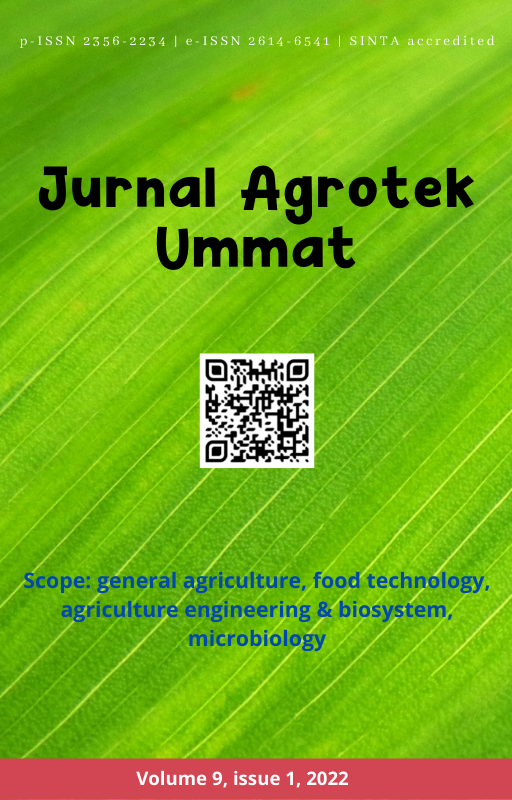Application of organic fertilizer through cutting bulbs on the growth and production of red onion (Allium ascalonicum L.) in dry land
DOI:
https://doi.org/10.31764/jau.v9i1.6738Keywords:
chicken manure, red onion, tuber cuttingAbstract
Red onion (Allium ascalonicum L.) is a spice plant whose needs as a kitchen spice continue to increase. Some of the obstacles faced in meeting community needs include the availability of inorganic fertilizer needs and seed preparation before planting. From this fact, it is necessary to cultivate through the use of organic fertilizers by cutting bulbs on shallot seeds before planting, so that it is expected to obtain the expected results. The study was conducted from May to July 2021. Field experiments were carried out using the split plot design method, as the main plot. Cutting tubers (P): P0 tubers that were not cut, P1 cutting in parts, P2 cutting in parts and subplots, namely the dose of organic chicken manure (D) D0 control, D1 15 tons/ha, D2 20 tons/ha. Plant variables include plant length (cm), number of leaves (strands). number of tubers per clump (tubers), number of tubers per plot (tubers), fresh weight of tubers per clump (g), fresh weight of tubers per plot (kg). The results showed that by giving a dose of chicken manure 20 tons/ha by cutting onion bulbs, the highest yield was 1.64 kg/plot or equivalent to 4.47 tons/ha
References
Aminah, I. S., Budianta, D., Parto, Y., & Sodikin, E. (2014). Tumpangsari Jagung (Zea mays L.) dan Kedelai (Glycine max L. Merrill) untuk Efisiensi Penggunaan dan Peningkatan Produksi Lahan Pasang Surut. Jurnal Tanah dan Iklim, 38(2), 119–128. https://doi.org/10.2017/jti.v38i2.6239
ARI MAYADEWI, N. N. (2007). Pengaruh Jenis Pupuk Kandang dan Jarak Tanam terhadap Pertumbuhan Gulma dan Hasil Jagung Manis. Agritrop, 26(4), 153–159. http://ojs.unud.ac.id/index.php/agritrop/article/view/3069
Azmi, C., Hidayat, I. M., & Wiguna, G. (2016). Pengaruh Varietas dan Ukuran Umbi terhadap Produktivitas Bawang Merah. Jurnal Hortikultura, 21(3), 206. https://doi.org/10.21082/jhort.v21n3.2011.p206-213
Badan Pusat Statistik dan Direktorat Jenderal Hortikultura. (2019). Produksi Bawang Merah Menurut Provinsi, Tahun 2015-2019. Data Lima Tahun Terakhir Kementerian Pertanian Republik Indonesia, 2019, 1. https://www.pertanian.go.id/home/?show=page&act=view&id=61
Batubara, L. R., Mawarni, R., Raka, R., & Pohan, R. (2021). RESPON PERTUMBUHAN DAN PRODUKSI BAWANG MERAH ( Allium cepa L ) TERHADAP KONSENTRASI AIR KELAPA DAN MEDIA TANAM SECARA VERTIKULTUR. Jurnal AGROTEK Vol. 8, No.1, April 2021. ISSN 2356-2234 (print), ISSN 2614-6541(online) Journal Homepage: http://journal.ummat.ac.id/index.php/agrotek, 8(1), 48–53.
Firmansyah, A. M., Liana, T., & Bhermana, A. (2017). The Effect of Age , Form and Seed Cutting to the Growth and Production of Shallot ( Allium ascalonicum L.) at Dry Lands with Low Altitude. Journal of Agricultural Science and Food Research, 8(4), 1–5.
Idris, B. M., & Imam, W. (2010). Effects of Various Types and Doses of Manure on Growth. 8(2), 40–49.
Jumini;Yenny Sufyati;N Fajri. (2010). J. Floratek 5: 164 - 171. PENGARUH PEMOTONGAN UMBI BIBIT DAN JENIS PUPUK ORGANIK TERHADAP PERTUMBUHAN DAN HASIL BAWANG MERAH, 5, 164–171.
Lee, J. (2010). Effect of application methods of organic fertilizer on growth, soil chemical properties and microbial densities in organic bulb onion production. Scientia Horticulturae, 124(3), 299–305. https://doi.org/10.1016/j.scienta.2010.01.004
Notohadiprawiro, T., Soekodarmodjo, S., & Sukana, E. (2006). Pengelolaan Kesuburan Tanah dan Peningkatan Efesinsi Pemupukan. 9, 1–19.
Nurhidayah, N. R. S. A. D. (2016). Pertumbuhan dan produksi bawang merah pada berbagai perlakuan berat umbi dan pemotongan umbi. Jurnal Agrotan, 2(1), 64–71.
Parman, S. (2007). Pengaruh Pemberian Pupuk Organik Cair terhadap Pertumbuhan dan Produksi Kentang (Solanum tuberosum L.). Anatomi Fisiologi, XV(2), 21–31. https://doi.org/10.14710/baf.v15i2.2569
Purba, S. N., Ansoruddin, & Batubara, L. R. (2018). PERTUMBUHAN DAN PRODUKSI TANAMAN BAWANG MERAH ( Allium ascalonicum L .). BERNAS Agricultural Research Journal, 14(2), 77–88.
Rokhminarsi, E., Utami, D. S., & Begananda, N. (2020). Pengaruh Aplikasi Pupuk Mikotricho pada Budidaya Bawang Merah dengan Pengurangan Dosis Pupuk N-P-K (The Effect of Mikotricho Fertilizer Application on Shallots Cultivation by Reducing the N-P-K Dose). Jurnal Hortikultura, 30(1), 47. https://doi.org/10.21082/jhort.v30n1.2020.p47-56
Rosmiah;Iin Siti Aminah;Dodi yusro. (2021). Pemberian pupuk organik limbah pertanian dengan jenis mikoriza berbeda. 7(2), 72–77.
Safrudin, A., & Wachid, A. (2015). TERHADAP PERTUMBUHAN DAN PRODUKSI BAWANG MERAH ( Alium ascalonicum L .). Fakultas Pertanian Universitas Muhammadiyah Sidoarjo, 12(1).
Soehendi, R., Arief, T., & Juwita, Y. (2016). Perkembangan Pertanian Lahan Kering di Sumatera Selatan (hal. 165–181).
Soetiarso; Thomas Agoes;, & Setiawati, W. (2005). Pedoman Umum Pengembangan Teknologi Inovatif pada Tanaman Bawang Merah.
Sulaeman, Suparto, & Eviati. (2005). Petunjuk Teknik Analisis Kimia Tanah, Tanaman, dan Pupuk (B. . Prasetyo, D. Santoso, & L. R. Widowati (ed.); I). Balai Penelitian Tanah.
Syawal;, F. A. R. R. (2017). Fitria Syawal;A Rauf;Rahmawati. Pertanian Tropik, 4(3), 183–189.
Tufaila, M., Darma Laksana, D., & Syamsu Alam, D. (2014). Aplikasi Kompos Kotoran Ayam Untuk Meningkatkan Hasil Tanamn Mentimun (Cucumis sativus L.) di Tanah Masam Application of Chicken Manure Compost to Improve Yield of Cucumber Plant (Cucumis sativus L.) In Acid Soils. Jurnal Agroteknos, 4(2), 119–126.
Walida, H., & Harahap, D. E. (2020). Pemberian kotoran ayam dalam ramgka rehabilitasi tanah ultisol. Agrica ekstensia, 14(1), 1–6.
Downloads
Published
Issue
Section
License
Authors who publish articles in Jurnal Agrotek Ummatagree to the following terms:- Authors retain copyright of the article and grant the journal right of first publication with the work simultaneously licensed under a CC-BY-SA or The Creative Commons Attribution–ShareAlike License.
- Authors are able to enter into separate, additional contractual arrangements for the non-exclusive distribution of the journal's published version of the work (e.g., post it to an institutional repository or publish it in a book), with an acknowledgment of its initial publication in this journal.
- Authors are permitted and encouraged to post their work online (e.g., in institutional repositories or on their website) prior to and during the submission process, as it can lead to productive exchanges, as well as earlier and greater citation of published work (See The Effect of Open Access).

